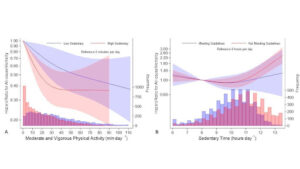Keywords: physical activity, sedentary time, health risk.
In this blog we describe our recent paper published in British Journal of Sports Medicine. This study took in total two years to complete, in which the work involved many steps for both planning, collecting data sources, harmonization and analysis of data, and finally the write up and review process, and involved researchers from Norway, Sweden, Denmark and the United States.
Why is this study important?
The 2020 World Health Organization guidelines on physical activity and sedentary behaviour was the first iteration of the guidelines to include a recommendation to limit sedentary time (1) due to research linking it to health risks, including non-communicable diseases and mortality (2). While no specific time limit was provided, the guideline suggests reducing sedentary time and compensating with more than the recommended 150-300 minutes of moderate-to-vigorous physical activity per week if high sedentary levels are unavoidable (1).
The current recommendations are based on research that has some limitations, such as the self-report methods of measuring physical activity, and the use of study-specific categorizations. Taken together, such factors limit our ability to say exactly how much physical activity and sedentary time is needed for health benefits (3, 4).
How did the study go about this?
We conducted an individual participant data meta-analysis by combining data from four large prospective cohort studies that use research grade activity monitors to measure physical activity and sedentary time. We harmonized physical activity and sedentary time data as well as other relevant covariates which could affect the relationship between physical activity/sedentary time and mortality risk (smoking, education, and alcohol intake). This enabled us to analyze the associations between physical activity and sedentary time with mortality risk in their original continuous form, eliminating recall bias and the need for study-specific categories.
What did the study find?
Being sedentary for over 12 hours per day raised the risk of death, but only in those doing less than 22 minutes of MVPA per day. Individuals doing more than 22 minutes of moderate-to-vigorous physical activity per day – equivalent of the WHO 150 min/week guidelines – had no increased risk of death with more sedentary time (See Figure 1B). This contradicts the WHO recommendation to exceed 150-300 minutes of MVPA per week when dealing with unavoidable high sedentary time.
We also found that those being highly sedentary had greater trade-off in forms of lower risk from the same amount of MVPA than did those having being less sedentary. However, if accumulating low sedentary time, higher MVPA was still associated with a substantial lower risk of death (see Figure 1A).

Figure 1. A) moderate-to-vigorous physical activity and risk of death. B) sedentary time and risk of death.
What are the key take-home points?
The take home message is that the trade-off from getting people more active in at least moderate intensity is high, and much higher than having people reducing sedentary time. Secondly, if people for any reasons are sedentary for most of the day, small amounts of physical activity will still lower the risk of death substantially, where meeting current lower-limit guidelines of 150 minutes/week abolish the higher risk of death from sedentary time.

Authors: Edvard H Sagelv, Bjørge H Hansen, Jakob Tarp.
References:
- Bull, F.C., S.S. Al-Ansari, S. Biddle, et al., World Health Organization 2020 guidelines on physical activity and sedentary behaviour. Br J Sport Med 2020;54(24):1451-1462.
- Dempsey, P.C., S.J.H. Biddle, M.P. Buman, et al., New global guidelines on sedentary behaviour and health for adults: broadening the behavioural targets. Int J Behav Nutr Phys Act 2020;17(1):151.
- Royston, P., D.G. Altman, and W. Sauerbrei, Dichotomizing continuous predictors in multiple regression: a bad idea. Stat Med 2006;25(1):127-41.
- Ekelund, U., K.E. Dalene, J. Tarp, et al., Physical activity and mortality: what is the dose response and how big is the effect? Br J Sports Med 2020;54(19):1125-1126.